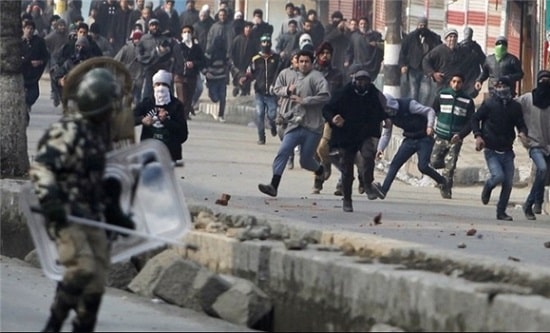
On 5 August, the far-right Hindu nationalist government of Indian prime minister Narendra Modi, with its newly won majority, unilaterally abolished the autonomous status of Jammu and Kashmir (enshrined in Article 370 of the Indian constitution). For decades, Kashmiri people have been fighting for the right to self-determination. With the abolition of Article 370, the Indian state has made its colonial occupation of Kashmir official.
Although the abrogation of Article 370 has been a persistent demand of the ruling far right coalition, what shocked many on the Indian left and centre was the fact that the ruling BJP could take away key conditions of the Indian union without any serious opposition. Lamenting only the future of Indian federalism, the Constitution and the rule of law, they ignore the fact that Kashmir’s ‘autonomy’ was already merely a word in the face of decades of violent occupation.
Previous governments, including the BJP and Indian National Congress, enforced the occupation of Kashmir through the naked violence of the army, and through pro-India comprador political parties. Since the 1980s, the Indian government has used these parties to create a facade of consent for its violent counter-insurgency campaigns.
Today the BJP is at the fore of an emboldened fascist movement; the comprador parties in Kashmir are no longer enough to carry out the designs of Indian nationalism. In July, BJP national general secretary Ram Madhav shared his vision for demographic engineering by settling 200,000-300,000 Hindus in Kashmir.
The next phase was the forceful annexation of Kashmir, violating accession agreements made in 1947 and 1948. India stationed around 800,000 soldiers in one region of Kashmir and instituted an indefinite communication and mobility curfew on the whole region. Article 35A, a clause which prevents people outside Kashmir from buying property and permanently settling there, has been effectively revoked. Since 5 August, India has jailed over 4,000 Kashmiris, mostly civil society members and politicians, even some who are pro-India. Roughly 300 have been detained without trial for up to six months under the Public Safety Act.
Both the government and Indian media farcically repeat the narrative of normality in the region. But independent and international media report over 500 large protests with calls for Azadi (freedom), and several areas, such as Anchar in Srinagar, being turned into autonomous zones by protesters barricading roads. Farmers have gone on strike, leaving apples to rot in fields; the government threatens to take over the harvest. Those resisting occupation must receive our unconditional support.
Kashmir conflict: legacy of British imperialism
The British Empire acquired the Kashmir valley in 1846 as spoils of the first Anglo-Sikh War, then sold the region to the feudal Dogra Dynasty for seven million Indian rupees. To cover this cost, Dogra rulers imposed expropriative taxation and land enclosures on the majority peasant population. This led to several anti-feudal uprisings and movements, including the 1932 formation of Sheikh Abdullah’s National Conference, which agitated for self-rule.
In 1947, when violence caused by the British Empire’s partition of India reached Kashmir, the Dogra rulers and paramilitaries carried out a massacre of an estimated 200,000 Muslims in the Jammu region to reduce its Muslim population share and prevent the region joining Pakistan. In the violent aftermath, where militias on both sides were pillaging and engaging in ethnic cleansing, the Dogra ruler Maharaja Hari Singh requested intervention from the Indian government.
Kashmir was thus divided into Pakistani and Indian regions. But the mood of Kashmiri people was not in favour of India, as it had intervened many times to support Dogra repression. Sensing the disquiet, Indian Prime Minister Jawaharlal Nehru agreed to temporary autonomy of Kashmir in 1948, until a plebiscite on independence could be held.
But this agreement was immediately broken. India tightened its control over Kashmir and started criminalising the independence and reunification movement. Slowly the autonomy provision became a farce, as India engaged in political repression and, with its massive military apparatus, committed several massacres, torture, and mass rape with impunity.
While not as violent as Indian-occupied Kashmir, Pakistan has militarised the Azad Kashmir region, repressed any movement which pursued the path of independence, and funded pro-Pakistan reunification movements. Since the 1990s, the conflict in Indian-occupied Kashmir has taken the lives of over 100,000 people; an estimated 10,000 have disappeared; and there have been heinous cases of mass rapes like Kunan Pushpora. Even after most of the separatist movement gave up armed struggle and called for dialogue in the late 2000s, India refused to come to the negotiating table.
The importance of self-determination
This new chapter, with the genocidal rhetoric of a fascist movement, should bring Indian progressives to unconditionally stand with the Kashmiri people for their right to self-determination. Instead, there are protests about India’s failure to follow the rule of law, and chauvinistic slogans like ‘Kashmir is part of India’. Without taking up the cause of Kashmiri freedom, the progressive movement in India will forever be in thrall to a rightward-shifting nationalist agenda.
Kashmir is not an exceptional case. For Balochistan, Manipur, Nagaland, Telangana, Eelam, and a thousand other indigenous lands, the promises of postcolonialism always rang hollow, as they were met with national capitalist violence for land, resources, and labour. The claims of both India and Pakistan on Kashmir have only led to similar violence. For revolutionaries in the region, the question of self-determination for Kashmir is central.
Freedom for Kashmir!
Abdul Vajid
Fight Racism! Fight Imperialism! No 272, October/November 2019




